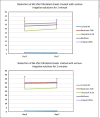Irrigation Solutions Negatively Affect the Viability and Function of Human Fibroblasts: An in vitro Study
- PMID: 36643380
- PMCID: PMC9834643
- DOI: 10.1159/000527110
Irrigation Solutions Negatively Affect the Viability and Function of Human Fibroblasts: An in vitro Study
Abstract
Introduction: Multiple irrigation solutions are used in orthopedic surgeries although there are limited studies on their lasting effects on human tissues. The purpose of this work was to investigate the cytotoxic effects of the irrigation solutions Bacitracin, Clorpactin (sodium oxychlorosene), Irrisept (0.05% chlorhexidine gluconate), and Bactisure (ethanol 1%, acetic acid 0.6%, sodium acetate 0.2%, benzalkonium chloride 0.013%, and water) on 3D cultures of human fibroblasts.
Methods: Two independent experiments with 6 replicates were performed for the following conditions: Control (saline), bacitracin, Clorpactin, Irrisept, and Bactisure. Human fibroblast cell sheets were exposed to these solutions (1 or 2 min), followed by three washes with warm saline. Cell sheets were then cultured for additional 5- and 7-day posttreatment. Cell viability was measured using the alamarBlue (AB) assay. The more cytotoxic the irrigant, the lower the AB reduction.
Results: For 1-min exposure time, significant differences in AB reduction were noted in Clorpactin, Irrisept, and Bactisure groups compared to control at both 5 days (Clorpactin p = 0.0003, Irrisept p = 7.31 × 10-15, Bactisure p = 6.86 × 10-14) and 7 days posttreatment (all groups p < 0.0001). The results were similar in the 2-min exposure groups. Bacitracin-treated fibroblasts displayed no significant difference at all measurement times compared to control.
Discussion: Impacts of irrigation solution exposure on cell viability were varied. Irrisept and Bactisure showed the highest cell toxicity even after a brief exposure (1 min), while bacitracin and Clor-pactin exposure showed smaller impacts on cell viability as compared to saline controls. This in vitro study provided insight into the effects of the irrigants on human cells and provides the groundwork essential to move to in vivo studies. Our findings raised the concern that some irrigation solutions may have negative impacts on wound healing and healthy cellular response.
Keywords: Anatomy; Cell biology; Cell viability; Cytotoxicity; Fibroblast; Fibroblast function; Fibroblast viability; Harmful irrigation solutions; Irrigation solutions; Orthopedic surgery; Physiology; alamarBlue reduction.
Copyright © 2022 by The Author(s). Published by S. Karger AG, Basel.
Conflict of interest statement
The authors have no conflicts of interest to declare.
Figures


References
-
- Anglen JO. Wound irrigation in musculoskeletal injury. J Am Acad Orthop Surg. 2001;9((4)):219–26. - PubMed
-
- Barrack RL, Engh G, Rorabeck C, Sawhney J, Woolfrey M. Patient satisfaction and outcome after septic versus aseptic revision total knee arthroplasty. J Arthroplasty. 2000;15((8)):990–3. - PubMed
-
- Leikin JB, Paloucek FP, editors. Poisoning and toxicology handbook. 4th ed. New York: Informa; 2008. Chlorhexidine gluconate; pp. p. 183–4.
LinkOut - more resources
Full Text Sources

